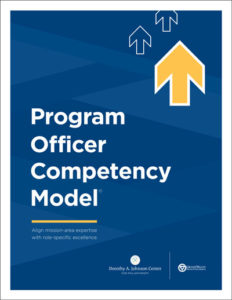Introducing the Program Officer Competency Model


 Over the past two years, the Johnson Center has been working to develop competency models for program officers and nonprofit leaders. We will use these models as a basis for ensuring that all of the professional education we offer aligns with the competencies — knowledge, skills, abilities, and other characteristics (KSAOs) — that make for the most effective performance.
Over the past two years, the Johnson Center has been working to develop competency models for program officers and nonprofit leaders. We will use these models as a basis for ensuring that all of the professional education we offer aligns with the competencies — knowledge, skills, abilities, and other characteristics (KSAOs) — that make for the most effective performance.
The development of the Program Officer Competency Model© included an analysis of more than 100 job descriptions; a review by competency model experts; and a set of nine focus groups with national and local grantmakers and local nonprofit leaders. The process was invaluable to honing in on the essential competencies and seeking to describe them.
We will also release models for nonprofit leaders and board members in early 2021.
We offer these models as contributions to the field of philanthropy to support the hiring, cultivation, and retention of staff, and — most importantly — to elevate the importance of these competencies over traditional credentials that often lean on formal networks and advanced degrees. Data suggests that hiring candidates based on demonstrated competencies, in addition to an undergraduate degree, is a more apt indicator of potential success than the candidate’s field of undergraduate study alone (Grigoryev, 2006). In other fields, their use has led to significant increases in the diversity of staff, talent retention, and overall performance (Talent 2025 and West Michigan Works!, 2018).
A competency model delineates the knowledge, skills, abilities, and other characteristics (KSAOs) that are required for effective performance in a particular job or profession. Many fields/professions (e.g., human resources and social work) are already using competency models to frame and inform professional development activities and position descriptions.
Competency models typically delineate a limited number of high-level categories of KSAOs, then break these down into sub-competencies, then identify the behaviors that demonstrate that an individual has this competence.
By defining the KSAOs that underpin effective performance, competency models enable those hiring or evaluating staff or designing professional development activities or other offerings to base decisions explicitly on the requirements of the position, thereby decreasing the influence of extraneous factors and unconscious bias.
The Program Officer Competency Model is designed to be very broad in scope. Depending on your theory of philanthropy (Patton, Foot, and Radner, 2015) a given foundation may emphasize certain KSAOs more than others. Some foundations, for example, may emphasize policy skills, while others might emphasize network building as a key strategy. The model can be used to guide the development of job postings, design professional development activities, or inform performance management. We will be looking to the field for use cases to help us understand how useful it is and where we can make enhancements.
Take a look at the high-level model now — and stay tuned for the full web-based version. We’d love to engage with you on how to use the model in your own work — and of course, we welcome your feedback.
Grigoryev, P. (2006). Hiring by competency models. The Journal for Quality and Participation, 29(4), 16–18, 39.
Patton, M., Foote, N., & Radner, J. (2015). A Foundation’s Theory of Philanthropy: What It Is, What It Provides, How to Do It. The Foundation Review, 7(4). https://doi.org/10.9707/1944-5660.1263
Talent 2025 and West Michigan Works! (2018, August). HireReach: Executive Summary. Retrieved from https://bit.ly/3sEjBse